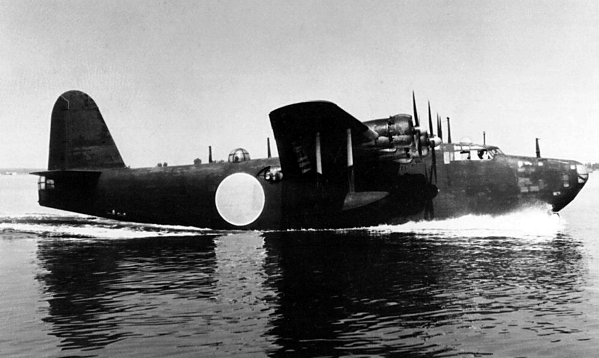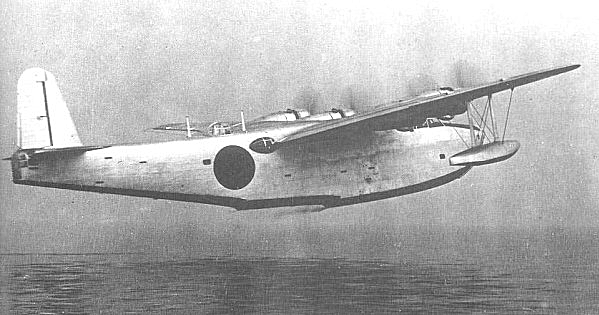
|
 |
Kawanishi H8K "Emily" |
 |
 |
 |
 |
 |
|---|---|---|---|---|---|---|---|
 |
 |
 |
 |
 |
|||
 |
||
|
The Kawanishi H8K flying boat (Allied code name "Emily") was an all-metal, four-engine, large-size, Type 2 Flying Boat used by the Imperial Japanese Navy and was considered to be the best flying boat of World War II. It was built to replace the Kawanishi H6K and to exceed the performance of the Short S.25 Sunderland and Sikorsky XPBS-1 Patrol Bomber. The Navy specification 13-Shi called for a top speed of 276 mph (444 km/h), a cruising speed of 207 mph (333 km/h) and a maximum range of 5,180 miles (8,336 km). It was ordered in 1938 the same time its predecessor, the Kawanishi H6K, went into service. A total of 167 of the type were built and it made its inaugural flight in January, 1941.1
The H8K had good performance, impressive speed and range, and was well armed and provided armor protection for the crew. Its offensive capability was very effective in anti-submarine campaigns and was the scourge of American submarines during the war. |
|
The cockpit sat high just forward of a cantilever wing and was powered by was powered by four 1,530 hp (1,140 kW) Mitsubishi MK4A Kasei 11 engines. The later version, the H8K2, was powered by four 1,850 hp (1,380 kW) Mitsubishi MK4Q Kasei 22 engines with water injection driving four-blade propellers.
It had eight small unprotected fuel tanks in the wings and six large, partially self-sealing, fuel tanks in the hull. It used a Co2 inert gas system for fuel tank fire protection and had a unique feature that if a hull fuel tank was pierced, the fuel would drain into the bilge and could be pumped back into the undamaged tanks. The fuel capacity was 4,500 gallons (17,040 liters). |

The prototype was heavily armed with three 7.7 mm machine guns in the ventral position and each side-hatch. Five 20 mm cannons were provided in the nose, tail, dorsal and waist blisters. Armament on the H8K1 was reduced to two 20 mm cannons in the dorsal and tail turrets and four flexible 7.7 mm machine guns and carried two 800 kg (1,764 lb) torpedoes or sixteen 60 kg (132 lb) bombs or depth charges. The H8K2 carried the same armament as the H8K1 plus two additional 7.7 mm machine guns in either side of the cockpit. Most late production aircraft utilized a Mark VI Air to Surface Vessel radar system for submarine detection and served with first-line units. It was also heavily armored and was considered to be the most difficult Japanese aircraft to shoot down.2 The H8K was involved in a second raid on Pearl Harbor on March 4-5, 1942 and this was the longest distance ever undertaken by a two-plane bombing mission, and the longest bombing sortie ever planned without fighter escort. Two airplanes left Wotje Atoll in the Marshall Islands and were refueled by submarine at the French Frigate Shoals. However due to cloud cover, the raid did not accomplish any significant damage and there were no American casualties. Another long distance mission had been planned for Midway, but was cancelled after the refueling submarine discovered that the French Frigate Shoals were occupied by American Forces.3 The H8K was used on a wide range of patrol, reconnaissance, bombing, and transport missions throughout the Pacific war. As a troop carrier, it could hold up to 64 soldiers. Only four aircraft survived to the end of the war. |
| Specifications: | |
|---|---|
| Kawanishi H8K2 | |
| Dimensions: | |
| Wing span: | 124 ft 8 in (38.00 m) |
| Length: | 92 ft 4 in (28.15 m) |
| Height: | 30 ft 0 in (9.15 m) |
| Weights: | |
| Empty: | 40,436 lb (18,380 kg) |
| Loaded: | 53,900 lb (24,500 kg) |
| Performance: | |
| Maximum Speed: | 290 mph (465 km/h) |
| Cruising Speed: | 184 mph (296 km/h) |
| Range: | 4,440 miles (7,150 km) |
| Service Ceiling: | 28,740 ft. (8,760 km) |
| Powerplant: | |
| Four 1,850 hp (1,380 kW) MK4Q Mitsubishi Kasei 22 14-cylinder radial engines. | |
| Armament: | |
|
Five 7.7 mm Type 97 machine guns in fuselage hatches, Five 20 mm Type 99 cannons in nose, dorsal, tail and waist positions plus two 800 kg (1,764 lb) torpedoes or two 1,000 kg (2,205 lb) bombs or depth charges. | |
| Radar: | |
| Mark VI Model 1 ASV radar. | |
Endnotes:
|
1. Rene J. Francillon, Japanese Aircraft of the Pacific War. Annapolis, Maryland: Naval Institute Press, 1995. 308. 2. Ibid. 310. 3. Ibid. 309. |
©Larry Dwyer. The Aviation History On-Line Museum.
All rights reserved.
Created September 12, 1997. Updated October 26, 2013.